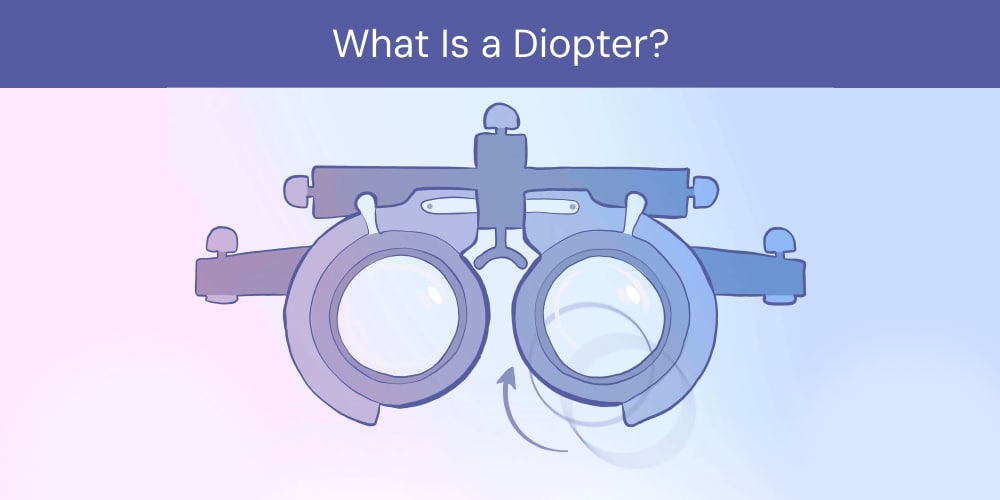
What Is a Diopter?
A diopter is the unit of measurement that describes the focusing strength of a pair of glasses. It refers to the numbers found on your optical prescription. The higher the number, the more blurred the world will appear around you without your glasses.
In a distance prescription:
- A positive number means you are farsighted.
- A negative number means you’re nearsighted.
What Is the Relationship Between Diopters and Focal Length?
If you know the focusing strength of a lens in diopters, you can calculate its focal length — the distance where light is focused.
Focal Length Explained
The focal length of a lens is the distance it focuses light beams coming from a long distance away. It is usually described in meters, which are similar to yards in length (1 meter = 1.09 yards).
A diopter and focal length have a reciprocal relationship. Taking the reciprocal of a diopter is easier than it may sound, and it will give you the focal length (in meters).
In other words, 1 divided by the number of diopters (D) in the lens gives you the focal length (F):
- F = 1 / D
The higher the diopter value (D), the shorter the focal length (F). For example, a 2.00 D lens focuses at half a meter because the reciprocal of 2 is 1/2, or 0.50.
Diopter Strength Explained
A diopter can have a minus or plus power. A handheld magnifier is an excellent example of a plus-diopter lens. It causes light to move the focus of the light closer. You can use this lens to focus sunlight on something to make it so hot that it will burst into flames. Plus lenses are thicker in the center and make things look larger when you look through them.
A minus lens will spread light rays out. When holding it in the sun, you can never get this type of lens to ignite your campfire because it does not create a point of focus. Minus lenses are thinner in the center, making an object behind them look smaller.
The higher the diopter value of the lens, the more it will focus light (plus lens) or spread out light (minus lens).
What if the light is not coming from the sun but from something much closer, like a book?
The close distance causes the light beams from the book to spread out, just like a minus lens.
Plus-diopter lenses are needed to allow these light beams to focus on the eye correctly.
This is why reading glasses have a plus-diopter power.
You may also like
What Are Different Diopter Strengths Used For?
Different diopter strengths are used to correct nearsightedness, farsightedness, and presbyopia — an age-related loss in near focusing ability that occurs in your 40s. Glasses help to focus incoming light so it lands directly on the retina, the light-sensitive tissue in the back of the eye. Your eye doctor determines the diopters needed in your glasses during your eye exam.
If you’re nearsighted, you can see better up close than far away. A nearsighted eye has too much plus power. As a result, light is focused too much, so it doesn’t land in the correct place inside the eye. A minus lens “neutralizes” this excess plus power of the eye, allowing it to focus precisely where it should — on the retina. This is why nearsightedness (myopia) is corrected with minus-diopter lenses.
If you’re farsighted, your faraway vision is better than up close. A farsighted eye has too little plus power, so light is not focused enough, and it doesn’t land in the correct place inside the eye. A plus lens gives the eye additional diopters so incoming light rays come to a precise focus on the retina. This is why farsightedness (hyperopia) is corrected with plus-diopter lenses.
Why Do I Need a Higher Prescription in Diopters as I Age?
As you age, you lose the ability to focus on things up close. By age 40 to 45, the crystalline lens inside the eye, which helps focus incoming light, has lost the ability to help you see clearly at reading distance. This is called presbyopia.
Lenses with plus power can help your eyes focus better up close. The more focusing ability you lose as you age, the more power you need. This is why the prescription for reading needs to be strengthened every few years. Your reading prescription will eventually stabilize.
When Was Your Last Eye Exam?
The eye's focusing power changes throughout life. Not wearing glasses when you need them can lead to blurry vision, eye strain, headaches, and even dangerous situations. Eye care professionals recommend that you have an eye exam every one to two years. Get an eye exam regularly to keep your eyes healthy and focusing well.










